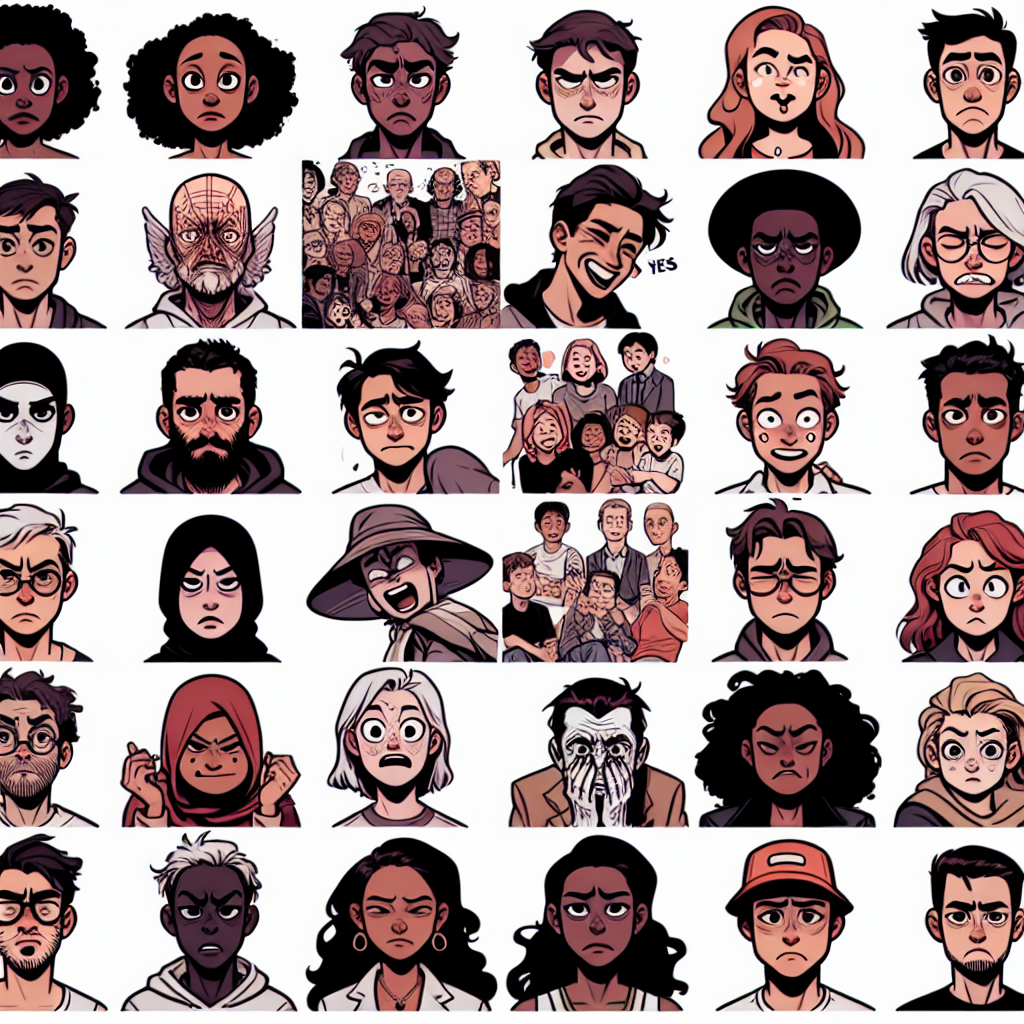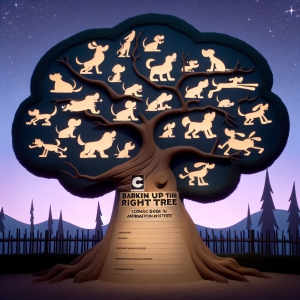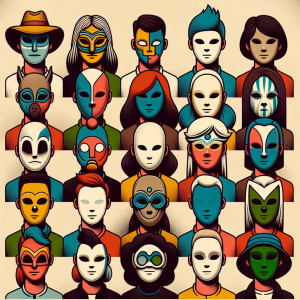Imagine flipping through a comic strip and suddenly encountering a character without any facial features—no eyes, no mouth, and no nose. At first, it might seem strange or unsettling, but as you delve deeper, these faceless figures may evoke a greater range of emotions than those with perfectly rendered features. So, how do these simplistic, yet powerful images communicate so much without the usual means of expression? This article explores the fascinating world of cartoon portraits, examining how they convey emotions, personality, and even narratives by accentuating the essence of expression without the need for traditional facial features.
The Allure of Simplicity: Understanding Faceless Art
In an age saturated with hyper-realistic art and detailed character animation, faceless portraits might strike you as a rebellious wave against artistic convention. This approach to character design offers its own allure—a stripping away of complexity to reveal the core essence of an emotion or idea. Just like a minimalist painting can evoke strong feelings with just a few brush strokes, faceless characters invite viewers to project their interpretations onto them, creating a unique dialogue between the art and the observer.
The Psychology Behind Faceless Characters
Studies in psychology suggest that our brains are wired to recognize faces and interpret emotions through them. However, when a face is absent, our brains engage differently. Faceless characters reduce cognitive overload, allowing for a more emotional and less analytical response. They appeal to universal aspects of human experience, tapping into our feelings rather than demanding analysis of specific traits.
Emotion Through Shape and Color
One fascinating aspect of faceless expressions is their reliance on non-verbal cues, mainly shape and color, to communicate feelings. Here are some methods illustrators use to convey emotions:
- Color Palette: Colors can evoke specific emotions. For instance, a warm palette with reds and oranges can give a sense of excitement, while cool colors like blues and greens may convey calmness or sadness. Artists cleverly use color to cue emotional responses even without a defined facial structure.
- Body Language: The way a character is posed or oriented can provide rich information about their emotional state. A slouched posture or closed arms may suggest sadness or defensiveness, while an open stance might denote joy or confidence.
- Iconic Shapes: Certain shapes are universally associated with specific feelings. For instance, round shapes might suggest friendliness and warmth, while sharp shapes could imply danger or aggression. In faceless portraits, these shapes become central to communicating deeper meanings.
Storytelling Through Minimalism
Faceless characters engage viewers by allowing them to fill in the gaps of a narrative. The absence of features encourages imagination. Each person brings their own experiences and emotions into interpreting the character’s intended message—a form of storytelling that transcends cultural boundaries. Artists can weave intricate tales without the need for complex facial expressions, leaving much of the interpretation open to the audience. This collaborative universe allows countless interpretations that may vary vastly from one viewer to another.
Facelessness in Different Cultures
Throughout history and across various cultures, faceless or featureless representations have appeared in art. They speak to philosophical ideas, religious symbolism, and social commentary:
- Japanese Manga and Anime: Characters such as those in “Hajime no Ippo” often feature minimalistic facial details, allowing for readers to project their emotions. This approach is intentionally inclusive, making it easier for viewers to see themselves in the story.
- Western Comic Art: Many indie comics utilize faceless characters to address themes of identity and societal norms, provoking thoughts about the essence of self. Productions like “The Arrival” by Shaun Tan highlight this minimalism in storytelling.
- Traditional Art: African masks often lack detailed human features, focusing instead on the essence of personality and spirit, representing unity rather than individuality.
Famous Faceless Icons in Pop Culture
Countless characters in pop culture embody this art form, serving as icons without pronounced facial features. Here are some notable examples:
- Stick Figures: Found across various media, stick figures convey humor, emotion, and life experiences in a simplistic manner, proving that sometimes less truly is more.
- Lee from “Ed Edd n Eddy”: This character’s simplistic design strips away individuality, allowing viewers to see a conglomeration of their thoughts and feelings during the show’s humorous plots.
- The Faceless Man from “Game of Thrones”: This character embodies a mystery that encourages curiosity and speculation, with his absence of features representing the unknown, which adds depth to the storyline.
Designing Your Own Faceless Character
Feeling inspired to try your hand at creating a faceless character? Here are easy steps to help you begin your artistic journey:
- Choose Your Concept: Think about the emotions or narrative you want to communicate. Is it happiness, sadness, or mystery? Your concept will guide your design.
- Focus on Shapes: Use shapes that evoke your character’s personality. Round shapes are inviting and friendly, whereas angular shapes can feel dynamic and fierce.
- Select a Color Palette: Choose colors that evoke the desired emotional response. Experiment with combinations until you find the perfect mood.
- Experiment with Posture: Illustrate your character in a pose that expresses their emotional state clearly through body language—remember that posture speaks volumes.
- Finalize and Refine: Once you have a concept sketch, refine your character. Decide if they need additional elements (clothing, accessories) that add layers to their story.
Conclusion: The Power of Interpretation
Faceless expressions challenge conventions and allow viewers to engage in storytelling on a deeply personal level. They create space for emotional resonance and individual interpretation, demonstrating the power that lies in simplicity. The beauty of faceless cartoon portraits lies not just in their design but in their capability to connect with audiences beyond the constraints of detailed facial expressions. So the next time you encounter a faceless character in a comic or animation, take a moment to ponder what they might be expressing. Who knows? You just might find your emotions reflected back at you in a way you never expected.
FAQs about Faceless Expressions
What are faceless expressions in art?
Faceless expressions refer to artistic representations, particularly in cartoons, where characters possess little to no facial features. This minimalist approach allows for emotional interpretation through non-verbal cues like shape and color instead of relying on detailed facial expressions.
How do faceless characters convey emotions?
Faceless characters utilize elements like body language, color and shape to express emotions. For example, the colors used can evoke feelings associated with warmth or sadness, while their posture can indicate confidence or defensiveness, enabling viewers to connect emotionally despite the absence of detailed faces.
Why do artists choose to create faceless characters?
Artists create faceless characters to foster a sense of universality and relatability, allowing audiences to project their feelings and experiences onto the characters. This artistic choice can lead to deeper emotional engagement and interpretation within the narrative.
Are there any famous faceless characters?
Yes! Many characters across different media are recognized for their faceless designs, such as stick figures, Lee from “Ed Edd n Eddy,” and The Faceless Man from “Game of Thrones.” Each of these characters symbolizes something significant while allowing viewers to fill in emotional gaps with their interpretations.
Can I create my own faceless character?
Absolutely! Start by deciding the emotion or story you want to convey. Focus on shapes, color choices, and body language to express your character’s essence without traditional facial features. Enjoy the creative process!








+ There are no comments
Add yours